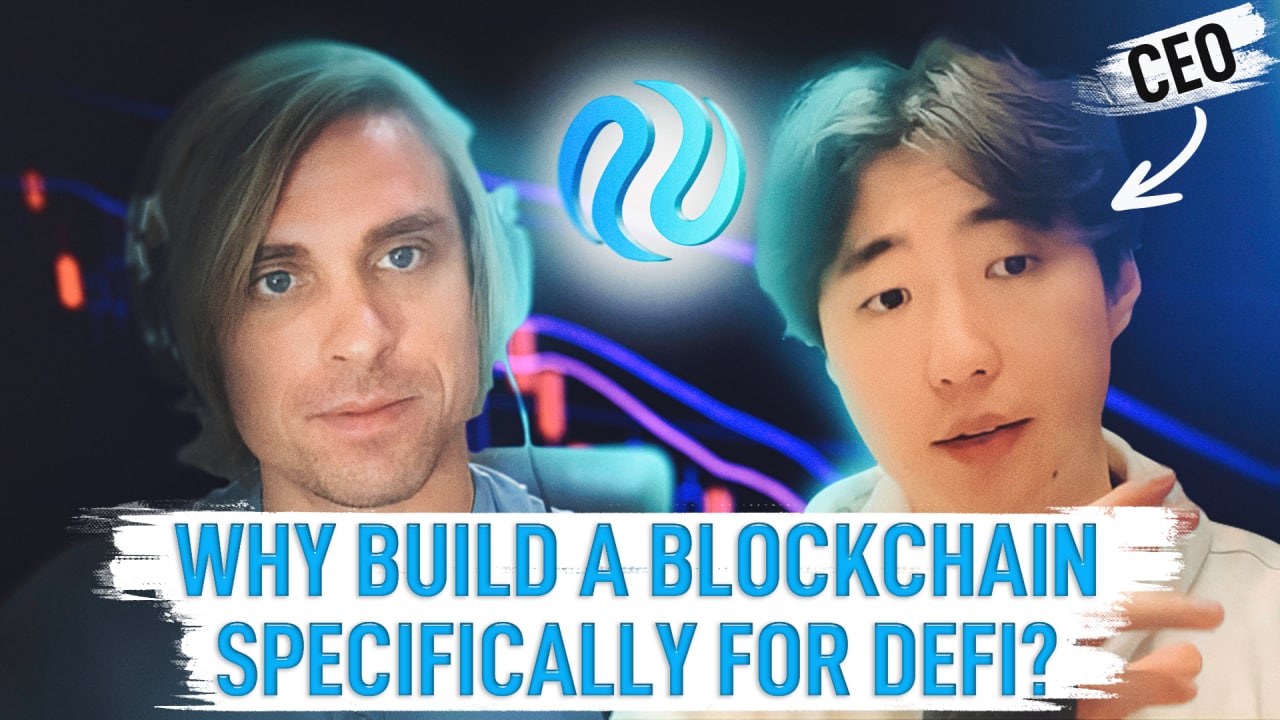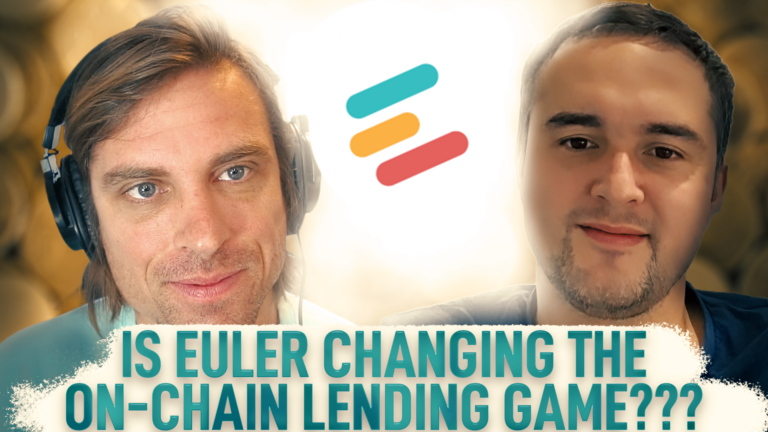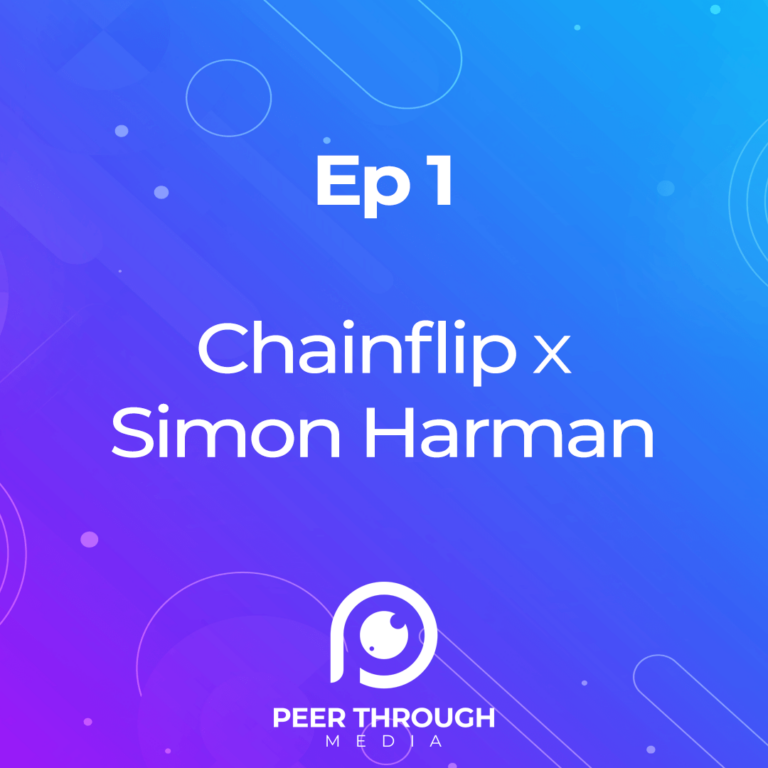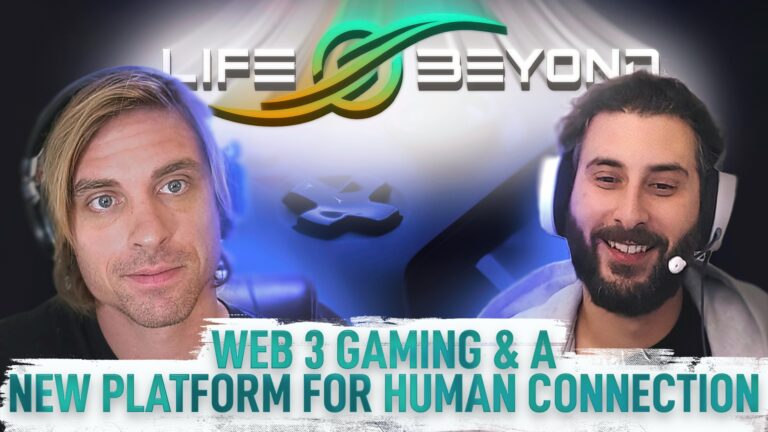Why Injective is Building a Defi specific Blockchain?
Peer Through Podcast – ep 3 – Injective
Ever wonder how a blockchain could be purpose-built for DeFi? What advantages would that hold for traders, dApp makers, and token holders? In this episode, I speak with Eric Chen, the founder, and CEO of Injective – A Blockchain Built for Finance. We touch on things like onchain orderbooks, front-end fee structures, interoperability, INJ tokenomics, and more. Tune in for insight into the protocol and the projects being built on top of Injective. https://injective.com/
Next Episode: Life Beyond: Exploring the Future of Gaming and Web3 or Earn Outsized Returns with Leveraged Vaults on Notional.Finance
Transcript of the Podcast Episode (created by AI)
[00:00:05.290] – Speaker 1
Alright. Hello and welcome to episode three of the Peer Through podcast, where we peer through to what’s next in tech and crypto. And on this episode, I am joined by Eric. Eric is from injective. Eric, do you want to go ahead and introduce yourself and give a broad overview of Injective before we dive in?
[00:00:26.120] – Speaker 2
Yeah, sure. Hey guys, this is Eric Chen, co founder and CEO for Injective Labs. So, Injective Labs is a software development firm focusing on contributing to injective the ecosystem. And Injective is a blockchain built for finance. Simply put, it’s an open interoperable layer. One blockchain powering the next generation of defy application and general financial application. And some of those might include decentralized spot and derivatives exchanges, prediction markets, lending protocols, and so much more. It has a few like very cool core features and provides a lot of powerful core financial infrastructure primitives that a lot of these application and DAP developers can leverage, which includes a fully decentralized MVV resistant launching order book and all forms of financial markets such as Spa, Perpetual, Future and Options are all fully on chain with minimal to zero gas fees.
[00:01:19.050] – Speaker 1
Interesting. Yeah. So I heard you mention a few things there. I have on chain order books, you have mev protection. You’re one of the first blockchains, at least that’s come across my purview that is very industry focused. You are a blockchain for D five. So can you tell me a little bit about that and why you thought that that was a play as compared to just a general layer one or a layer two or what other options you have out there? So why DFI exactly and how?
[00:01:47.490] – Speaker 2
Yeah, I think the general inspiration for kind of like the architectural or design choice for Injective as an ecosystem and as a chain is kind of stemming through the early days of Injective Labs where we’re kind of exploring all different solutions and trying to come up with a hypothetical application. And it became very clear early on that we just couldn’t find a suitable kind of base layer or infrastructural layer blockchain that can suit our needs. And it became very, very clear as we’re progressing this journey, that by being a blockchain that specializes in or hyper focused on addressing financial needs or defy needs or really kind of optimizing for a lot of those core underlying infrastructure components it can allow for kind of this really hyper aligned ecosystem and also an infrastructure that’s best suited and best possible for this subset of developers and projects and basically users. And a lot of these features, you simply won’t be able to find it on generalized environments or LTE solutions because generally these type of blockchains like Salana Ava are trying to address for a much more generalized need and it has a various different level of trade off for a lot of specific applications.
[00:03:12.900] – Speaker 2
And one kind of fundamental point is that a lot of financial applications requires a highly dynamic and low cost low transaction cost order book margining and general derivatives and also options and also lending infrastructure that can basically allow for really, really blazing fast block time but also at the same time hyper stability and also low transaction cost. And by optimizing for these specific type of use cases and features, these developers can build a lot of really amazing application such as fully decentralized on chain order book based decks which allows for ten x, if not 100 x more capital efficiency than AMS. And then on top of that, a lot of the base layer infrastructure that resolves a lot of the MTV considerations that matches orders and also undergoes the order book matching process in a really, really fair way with no possible room for sandwich attack or any type of exploitative behaviors. And I think that, on the other hand, is also a very critical tool. So instead of trying to build hacky solutions or trying to build, like, external tools or applications that might kind of alleviate these problems that are extremely difficult to resolve or address on a generalized and monolithic chain, why not?
[00:04:48.490] – Speaker 2
Just build it from the ground up and be maximally composable and compatible with the existing ecosystem and really build a chain and kind of like the community and also the platform that’s kind of irreplaceable as a player within the space compared to a lot of the hard to differentiate generalized layer one environments.
[00:05:13.250] – Speaker 1
Interesting. Yeah. I do like how you’re kind of going at the heart of what blockchain is at the moment and a lot of that is defy and finance. Now, I want to make sure I understand this correctly. We’ll look at this from a developer perspective first. So to simplify what you said, am I correct in understanding that if I was a developer there are built in components that help me with my order book and say, mev protection? If I were to launch a deck, it is easier to do so on injective because I can use your pre built components as compared to say, Ethereum, where you might be building those solutions for yourself or forking them from a different project.
[00:05:50.210] – Speaker 2
Yeah, as a matter of fact, setting up your own kind of exchange, whether it be Spot, whether that be derivatives, it could be as simple as downloading the SDK and using some of the reference applications and launching it in less than an hour or sometimes even a few minutes. And that process is extremely seamless. Everything is taken care of and obviously it doesn’t stop there. You can do a lot of very creative things. You can build like smart contracts using the Cosmos layer and you can have a lot of really, really advanced features. The current state of the injective ecosystem is that there’s a lot of dexus kind of having their own focus and yet sharing the liquidity and flow at the same time. Some of them are probably focusing on events, signing features, events, training features, et cetera. Some of them are probably focusing on more like community engagement and also different types of activity that can really retain a user base. And some of them are focusing on driving new features and focusing on building a specific type of integration or ramps, et cetera. I think for Helix’s case, recently integrated with Fiat on Ram to kind of round out the stack and all these are basically kind of room for different types of developers or projects to build on top of.
[00:07:20.380] – Speaker 2
Doesn’t have to worry about kind of like the base layer complexities, doesn’t really have to worry about bootstrapping liquidity and really get rewarded or be incentivized through the users and the volume and the traction that they bring in.
[00:07:37.730] – Speaker 1
Amazing. So you mentioned Helix, that’s kind of the premier decks on Injective, and I want to get to how a trader or a user of the blockchain begins to use Injective. But first I wanted to touch on a few more things, more from a build perspective. You mentioned you’re in the Cosmos ecosystem, you mentioned interoperability. And it seems that you feel that you have a way that’s a little bit better than just simply bridging back and forth between chains. So could you explain to me kind of how you’re interoperable with other chains such as Ethereum, such as the Cosmos main chain, and then also why it’s kind of better than just using a bridge and all that? Because there’s been a lot of problems with cross chain, to say the least, when it comes to hacks. What are you guys doing there?
[00:08:32.310] – Speaker 2
Yeah, I think one of the most interesting aspect is that a lot of the major bridges and infrastructures are already integrated with Injective. I think the recent kind of prominent integration is probably the Warmhole integration which brings over any type of assets and will kind of scale the access to different ecosystem alongside with warmhole’s integration. And then on top of that, I think one of the most interesting parts that if you go on Helix or if you go on J, dojo Dexterium, Wavely or Cordy exchange all those DEXes on top of injective you will realize that all you need to do is just connect your Metamas wallet or any type of wallet you might be familiar with, maybe even the kepler wallet, et cetera. And you don’t need to switch network. It looks and feels stuck as if you are just interacting with kind of like an exchange straight from Ethereum. And I think that is a really, really interesting and very, very probable type of integration and compatibility the user can feel and kind of try it out right away. On top of that, there’s a built in bridge connecting the chain with Ethereum that’s symmetrical in terms of security between the Injective chain, the blockchain security, and also the bridge security.
[00:09:51.250] – Speaker 2
And this basically ensures that any type of bridge risk or any type of potential hacks and stuff like that is all symmetric to the security of the chain itself, which is obviously very secure. And I think one of the most important aspect is also that this is a D Five focused, this is a kind of like exchange ecosystem focused networking and blockchain. So this means that all the stakeholders and all the validators will be aligned to make different types of governance decisions, make different types of chain upgrades, and also future additions based on the needs and wants of this specific sector. And this obviously is extremely helpful during extreme circumstances. Let’s say there’s a hack on the prominent application on top of Injective, or there’s some issues with a bridge. The validators can likely react very, very quickly during the early days to be able to ensure that all the users or all the participants in the ecosystem are safe and secure.
[00:10:59.970] – Speaker 1
Amazing. Good to know. All right, so Injective is how old now and what are some major milestones you guys have already hit that you’d like to kind of share with the community and then I would like to get into how I start using Injective or something like that.
[00:11:19.120] – Speaker 2
Yeah. So Injective is slightly over one year old after a canonical maintenance. So far to date, there’s been 144,000,000 on change transactions. I think over 800,000 plus Inj burned coming from the exchange ecosystem and Dexus fees. I think there’s over $7.8 billion in cumulative trading volume and might be more. This number is, last I checked, and then over 50% of the total supply is staked to secure blockchain. And on top of that, there’s a fiat on ramp integration and recently for the past two months, it also achieves 1 second average block time with an average fee per transaction of 0.2 cents. Sorry. $0.2.
[00:12:11.130] – Speaker 1
Amazing.
[00:12:11.980] – Speaker 2
Yeah, basically it’s been very crazy. There’s been a lot of ecosystem adoption, especially after the recent issues around custodial platforms and centralized exchanges. We’ve seen ten plus projects just weeks after the FTX collapse building on top of Injective. We’ve seen a huge general growth in activity and user base, so we’ve just been handling all the traction.
[00:12:40.460] – Speaker 1
That’s amazing. Yeah. I haven’t been using centralized exchanges for quite some time and it seems like hopefully the good that comes out of this FDX thing is death to centralized exchanges and people start moving into the centralized world. And your case, hopefully they start moving too objective. What are some kind of gaps or projects that you are excited about that are being built on top of Injective that either people can start using today like go on in their live right now, or maybe some coming down the pipeline.
[00:13:15.730] – Speaker 2
Yeah. So first of all, I think one of the most exciting projects currently building and recently is getting a lot of traction and probably the most novel amongst the Dexies out there is Frontrunner because they’re tackling the sports betting industry and the general gaming industry. And it’s certainly like an idea that the team pursued that is completely kind of outside of our initial imagination of how the blockchain can be used for or the type of projects that can be building on top of Injective. So always been keeping an eye on them, supporting them. They’ve been like crazy in terms of revamping a lot of the stuff that we built out of the box and generally coming up with very, very creative ways of designing the exchange, designing the general platform. It makes us really look and feel like you’re not really interacting with a three app, you’re not really interacting with Dex or like a blockchain. It really just feels like a web app. And generally the user can log in through their email access and on ramp, through any type of fiat, on ramps, et cetera. And a lot of user might just leave the platform without even realizing that Injective is powering all this.
[00:14:42.320] – Speaker 2
And that’s really, really fascinating for me. And on top of that, there’s been a lot of really exciting developments. I think Astroport is, by the time one comes out, has announced their testnet deployment on top of Injective, with maintenance falling suit very soon. And then there’s also a lot of exciting developments around Project X, which will come out shortly after some of the upcoming deployments, et cetera. I think all of these are really rounding out and building up the Injective kind of smart contract ecosystem and building up a lot of really fundamental building blocks and components for what a lot of the early community members envisioned for what Injective will look like.
[00:15:29.870] – Speaker 1
Okay, great to know. So let’s go from a user perspective here. If I wanted to use Injective to play some bets on some sports games, I would go to front runner. What does it look like for someone who’s relatively crypto native? You mentioned slightly earlier, like, am I just connecting my MetaMask? Do I need inj for gas? How do I get started? If, let’s say I’m coming from a basic ethereum background knowledge, what would I do?
[00:15:57.590] – Speaker 2
Yeah, I mean, try using Helix and as an ethereum user without understanding Injective, without having anything to do with Injective previously, try using Helix. You’ll realize that the notion of the native token which is inj is completely abstract away from the user end all the transactions that are sent through the e wallet. And you’re not really connecting to a new chain, to a new network. As a matter of fact, on your asset page there’s a deposit, there’s a withdrawal, and all this flow is kind of meant for Helix to be designed and to have a user experience of somewhat like a centralized platform, even though the back end and what’s beneath it is fully decentralized and fully on chain. And then on top of that, you get to see the overall look and feel and the trading experience of some typical centralized exchanges you might see out there. And I think that’s definitely one of the most wonderful thing about injective.
[00:17:04.510] – Speaker 1
Interesting. So you’re saying my apologies because I haven’t used it. You’re saying I just connect my MetaMask click, I don’t need to, how am I paying gas?
[00:17:14.730] – Speaker 2
So that’s actually one really interesting mechanism that just kind of goes to show like having like a sector focus or having a subset of developer focus kind of enables a lot of really amazing features that the general monolithic and blockchains generally don’t realize or couldn’t address. So one cool feature here is that basically the application pays for gas on your behalf. And they have this kind of natural incentive to do so, because all the user activity, such as placing limit orders, such as executing trades, et cetera, 40% of those fees will go to the DEXes and the projects that’s kind of hosting or providing the front end. And this kind of allows first of all for these projects to build really, really amazing user experience, really to engage. But on the other hand, it allows the user to completely kind of forget about the notion of needing like a native token. That all the blockers and barriers when it comes to onboarding, to a platform or to a blockchain that has its own native token. And this is one of the most fascinating things about injective.
[00:18:31.100] – Speaker 1
Interesting. So I’ll give it a try then. I don’t need to change my RPC endpoint on my MetaMask or anything like that. I just head over to Helix and go exactly. Okay, very cool, I’ll give it a try. One more thing I want to touch on is you keep mentioning the Inj token. Everybody always wants to know about the token. So could you give me a little bit of the Inj token use case, maybe some of the tokenomics just give us an overview of inj.
[00:19:00.190] – Speaker 2
Yeah, I think the native token is very similar to most of the layer. One blockchains, it secures network, it secures the blockchain through a proof of state mechanism. General users get to delegate to a validator or set up their own validator to earn proof of state rewards. And on top of that there is one very interesting mechanism which is any type of exchange module fees or any type of application fees, any type of revenue coming from the ecosystem, coming from the applications are all kind of collected and then undergoes like a weekly auction and burn. So market makers, et cetera, can participate in auction by bidding using a native token and the winning bid, they basically get to tap into that fee pool and the protocol itself will just burn the proceeds of inj coming from it. So it’s very rarely that for DFI application case or for general kind of industry that there’s such like a very concrete and quantifiable revenue coming from a protocol.
[00:20:12.930] – Speaker 1
Okay, so you’re saying kind of every gap on the protocol shares a portion of their revenue with inj in general.
[00:20:21.190] – Speaker 2
Exactly.
[00:20:22.390] – Speaker 1
Okay, very cool. And you can stake inj too, right?
[00:20:27.500] – Speaker 2
Yeah. So that’s basically participating in a consensus through proof of stake. I think the current staking reward is around 14%. I believe it falls similar to the staking mechanism and proof of stake mechanism as cosmos, et cetera. So that’s kind of like a general perks of being on top of a proof of stake blockchain.
[00:20:47.930] – Speaker 1
Okay, awesome. And then just for because I’m not always the smartest guy, can you break down that bid and burn system in a little bit more plain terms? So a market maker would go in and bid on the fee pool, but then as the fee pool just burn. So why would a market maker bid on the pool? Sorry, can you break that down?
[00:21:07.560] – Speaker 2
So basically, let’s say there’s like 100 applications, et cetera. And these applications, let’s say they all utilize the exchange module, which kind of provides the order book, et cetera. But there are fees baked into the kind of exchange module itself determined by governance. So some markets might have ten bips, which is a fraction of a percent of fees for every single dollar transacted. And these fees are generally, let’s say, collected in like UST USDC, and different types of stable coins, sometimes different types of assets in general. And then afterwards, basically, it gets aggregated every week collected into kind of like this pool of assets. And it undergoes an auction where basically people can bid using the native token inj. So let’s say the pool itself has $20,000 worth for this week. It could be stable coin, could be some form of different types of asset. And people bid using the native token, which is inj probably roughly equal to $10,000. Usually people bid with a percentage of discount and basically the winning bid will get kind of like the pool that’s beneath it. And then the winning bids IMJ, will be taken by the protocol and be burnt.
[00:22:36.970] – Speaker 2
And then the market maker kind of gets to or any type of bidder participating in this auction, which you can see through hub injective network, will basically get to kind of earn a spread or just have access to that asset pool.
[00:22:53.110] – Speaker 1
Interesting. Okay, I think it all pieced together there. I like that a lot. So let me see if I can break it down to make sure that I make sense. At the beginning of the conversation you noted how building on injective for developers is a lot easier because you have this built in on chain order book and all of these various components. So those various components are then almost owned by the injective protocol. Then you mentioned how whoever creates the front end essentially gets 40% of the fees. So then those remaining 60%, or at least some portion of those fees are sent into a pool. And that pool is bid on by market makers with the Inj token, maybe they can get 20,000 worth of USDT for like $19,000 value of Injective. They get that little discount and the Injective token is burned. Is that kind of cool? Yeah, I like it. All right, I guess. Anything else you want to share on Injective? And then I’m just going to ask you a few questions about the state of DFI and of Blockchain just to hear your thoughts, but anything else you want to add about Injective before we move on from there?
[00:24:03.250] – Speaker 2
Yeah, I think definitely stay tuned. There’s a lot of really exciting news coming out with a lot of different projects deploying on top of the ecosystem and a lot of upcoming collaborations, et cetera. I think the best place to learn more about Injective will be starting off the website like Injective.com, maybe to Twitter as well, which is injective underscore and begin the journey there. And yeah, I’m not sure when this podcast is going to come out, but I’m sure there has been a few announcements already, but there’s only more to come.
[00:24:40.490] – Speaker 1
Amazing. That’s great to know. Okay, peering through to the future, what do you see as one of the next major milestones or hurdles that will kind of bring defy to that next level, bring more in, more institutions, et cetera? What are you really looking out for here over the next year, two years, three years in the blockchain space?
[00:25:05.010] – Speaker 2
Yeah, I think generally, currently one of the biggest issue around D Five is the lack of capital efficiency. Lending capital could have been better utilized understanding the risks associated with lending protocols in general and also generally the predominant source of a liquidity outlet, russian AMM, which is a fairly inefficient liquidity deployment to say the least. And then on top of that, I would say generally their lacks kind of like a kind of credit system or like strong composability that allows for this vertical stack to all come together. And I think the current state of D Five is certainly a lot of different types of standalone, relatively speaking, siloed apps running on their own and introducing liquidity in one way or another, composed of each other in one way or another, but nothing too significant and nothing too strong. What I’ve seen in the future is that there’s going to be a lot more integration, a lot more kind of composability, and there’s going to be a lot more different types of automated deployment and automated processes to make. Sure that all these kind of, like, relatively more siloed protocols and applications gets to basically really interact with each other, gets to really compose on top of each other and gets to really have the same shared kind of synergy and also congregated liquidity.
[00:26:43.650] – Speaker 2
I would say another really big pain point is generally the lack of a credit system within D Five. You do see that lending protocol, et cetera, have this over collateralized kind of like ecosystem, but kind of like what drives the capital efficiency of a lot of the traditional markets. And obviously it has seen failure throughout history, but certainly it has also promoted a lot of economic growth is this general notion of credit, which kind of goes back into the capital efficiency argument as well. And I think one simple case is that if you have kind of like a lending position, let’s say you collateralize your if to borrow USDC or USDT, but you want to maybe use that USDC or USDT to purchase something else, recolateralize it or swap out the collateral, et cetera. Those processes are very, very difficult. You generally have to do it natively within that platform or you’re heavily limited in terms of the actions that you can partake. This is something really exciting that Injective enables is basically kind of like this prime brokerage account system, which is this account, let’s say it’s a sub account or it’s kind of like a sub address concept basically that you get to put assets into and you have control.
[00:28:20.530] – Speaker 2
You can do actions to it such as placing limit order, placing opening derivative positions, closing derivative positions, or buying certain asset, et cetera. But at the same time your entire portfolio act as a collateral, not just like a singular asset that you have to kind of lock up, et cetera. So this means that your entire portfolio gets to undergo like global margining, portfolio margining, cross margining, you get to borrow against your entire portfolio much like kind of like a prime brokerage account. And this kind of allows for just so much greater capital efficiency without most importantly compromising on the base layer kind of solvency of the platform. So it can be like a credit pool, lending pool that kind of underwrites and provides kind of like this lending capital to allow for these type of leverage with their internal risk system. And this is an isolated risk. So this basically allows for the lack of or like basically any type of issues such as FTX or any type of issues such as Mango just simply wouldn’t happen because the risk is all contained with the lending provider of that particular service.
[00:29:35.510] – Speaker 1
Okay, very interesting. Yeah, I agree. A credit system beyond just over collateralization would be great for the blockchain. So I’m glad to hear you’re excited about that. Yeah, that all seems good to me. I’m excited to try out Helix. I want to see this new interface. I want to kind of understand the concept. It’s not worrying about onboarding to a native token and then using that blockchain. So that all sounds great to me. Any last words for the viewers out there? Is there any final thing you want to send them to or let them know?
[00:30:14.870] – Speaker 2
Yeah, if someone wants to try Helix, go to Helixapp.com. And if you want to check out the overall ecosystem, go to Injective.com.
[00:30:22.850] – Speaker 1
Awesome. Well Eric, thank you so much for your time.
[00:30:25.080] – Speaker 2
Time.
[00:30:25.420] – Speaker 1
This was insightful. I’m certainly going to be watching Injective. I like your approach of really going at the heart of DFI with a specific blockchain and exciting times. Thanks for building great.
[00:30:37.820] – Speaker 2
Really appreciate it. Thank you so much.
[00:30:39.640] – Speaker 1
Thank you.
Injective (INJ) Podcast Summary AI
(The following summary was generated from an AI parsing through the podcast)
In short, Injective is a blockchain built for decentralized finance (DeFi) applications. It is designed to be an open and interoperable layer, providing powerful financial infrastructure primitives for developers to build on, such as a fully decentralized and MEV-resistant order book. The focus on DeFi allows for a highly dynamic and low-cost financial infrastructure, with features such as low transaction costs and fast block times, that are optimized for financial applications. This allows for developers to build fully decentralized on-chain orderbook-based platforms that are more capital efficient than traditional centralized platforms, while also providing a fair and stable environment without the possibility of exploitative behaviors.
Injective is slightly over one year old. It has had 144,000,000 on-chain transactions, over 800,000 INJ burned from exchange ecosystem and DEX fees, and $7.8 billion in cumulative trading volume. Over 50% of the total supply is staked to secure the blockchain. Additionally, there are several major milestones that have been achieved, such as the launch of the Helix decentralized exchange, the integration of various bridges and infrastructure, and the alignment of stakeholders and validators to make governance decisions and upgrades that benefit the DeFi ecosystem.
The Inj token is used to secure the Injective network through a proof of stake mechanism. Users can delegate their tokens to validators or set up their own validator to earn staking rewards. Additionally, a portion of the fees collected from the applications built on Injective, such as decentralized exchanges, is put into a weekly auction and burn. Market makers can participate in the auction by bidding with INJ and the winning bid will be able to tap into the fee pool, while the remaining INJ from the auction will be burned. This incentivizes market makers to participate in the auction as it allows them to tap into the fee pool, which can provide a steady source of revenue for them.






